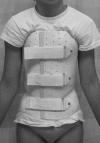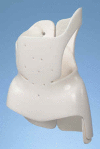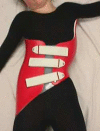A history of bracing for idiopathic scoliosis in North America
- PMID: 19462214
- PMCID: PMC2816759
- DOI: 10.1007/s11999-009-0888-5
A history of bracing for idiopathic scoliosis in North America
Abstract
The care of the patient with scoliosis has a history extending back over two millennia with cast and brace treatment being a relatively recent endeavor, the modern era comprising just over half a century. Much of the previous literature provides a modest overview with emphasis on the history of the operative management. To better understand the current concepts of brace treatment of scoliosis, an appreciation of the history of bracing would be helpful. As such, we review the history of the treatment of scoliosis with an emphasis on modern brace treatment, primarily from a North American perspective. Our review utilizes consideration of historical texts as well as current treatises on the history of scoliosis and includes discussion of brace development with their proponents' rationale for why they work along with an appraisal of their clinical outcomes. We provide an overview of the current standards of care and the braces typically employed toward that standard including: the Milwaukee brace, the Wilmington brace, the Boston brace, the Charleston brace, the Providence brace and the SpineCor brace. Finally, we discuss future trends including improvements in methods of determining the critical period of peak growth velocity in children with scoliosis, the exciting promise of gene markers for progressive scoliosis and "internal bracing" options.
Figures







Similar articles
-
A comparative study of TLSO, Charleston, and Milwaukee braces for idiopathic scoliosis.Spine (Phila Pa 1976). 1998 Nov 15;23(22):2404-11. doi: 10.1097/00007632-199811150-00009. Spine (Phila Pa 1976). 1998. PMID: 9836354
-
Brace treatment during pubertal growth spurt in girls with idiopathic scoliosis (IS): a prospective trial comparing two different concepts.Pediatr Rehabil. 2005 Jul-Sep;8(3):199-206. doi: 10.1080/13638490400022212. Pediatr Rehabil. 2005. PMID: 16087554
-
Bracing for scoliosis in 2014: state of the art.Eur J Phys Rehabil Med. 2014 Feb;50(1):93-110. Eur J Phys Rehabil Med. 2014. PMID: 24622051 Review.
-
Nighttime bracing with the Providence brace in adolescent girls with idiopathic scoliosis.Spine (Phila Pa 1976). 2001 Sep 15;26(18):2006-12. doi: 10.1097/00007632-200109150-00014. Spine (Phila Pa 1976). 2001. PMID: 11547201
-
Bracing Scoliosis - State of the Art (Mini-Review).Curr Pediatr Rev. 2016;12(1):36-42. Curr Pediatr Rev. 2016. PMID: 26769613 Review.
Cited by
-
Efficacy of Computer-Aided Design and Manufacturing Versus Computer-Aided Design and Finite Element Modeling Technologies in Brace Management of Idiopathic Scoliosis: A Narrative Review.Asian Spine J. 2021 Apr;15(2):271-282. doi: 10.31616/asj.2019.0263. Epub 2020 Apr 24. Asian Spine J. 2021. PMID: 32321200 Free PMC article.
-
Adolescent idiopathic scoliosis: indications for bracing and conservative treatments.Ann Transl Med. 2020 Jan;8(2):28. doi: 10.21037/atm.2019.09.69. Ann Transl Med. 2020. PMID: 32055619 Free PMC article. Review.
-
Comparison of the efficacy of thoracolumbosacral and lumbosacral orthosis for adolescent idiopathic scoliosis in patients with major thoracolumbar or lumbar curves: a prospective controlled study.Front Pediatr. 2024 Apr 2;12:1368201. doi: 10.3389/fped.2024.1368201. eCollection 2024. Front Pediatr. 2024. PMID: 38628358 Free PMC article.
-
A Comprehensive Review of the Historical Description of Spine Surgery and Its Evolution.Cureus. 2024 Feb 19;16(2):e54461. doi: 10.7759/cureus.54461. eCollection 2024 Feb. Cureus. 2024. PMID: 38510905 Free PMC article. Review.
-
The biomechanical performance of the night-time Providence brace: experimental and finite element investigations.Heliyon. 2020 Oct 17;6(10):e05210. doi: 10.1016/j.heliyon.2020.e05210. eCollection 2020 Oct. Heliyon. 2020. PMID: 33102843 Free PMC article.
References
-
- Allington NJ, Bowen JR. Adolescent idiopathic scoliosis: treatment with the Wilmington brace. A comparison of full-time and part-time use. J Bone Joint Surg Am. 1996;78:1056–1062. - PubMed
-
- Andriacchi TP, Schultz AB, Belytschko TB, Dewald R. Milwaukee brace correction of idiopathic scoliosis. A biomechanical analysis and a retrospective study. J Bone Joint Surg Am. 1976;58:806–815. - PubMed
-
- Apter A, Morein G, Munitz H, Tyano S, Maoz B, Wijsenbeek H. The psychosocial sequelae of the Milwaukee brace in adolescent girls. Clin Orthop Relat Res. 1978;131:156–159. - PubMed
-
- Blount W, Schmidt AC, Keever ED, Leonard ET. The Milwaukee brace in the operative treatment of scoliosis. J Bone Joint Surg Am. 1958;40:511–525. - PubMed
Publication types
MeSH terms
LinkOut - more resources
Full Text Sources
Medical
Research Materials
Miscellaneous

